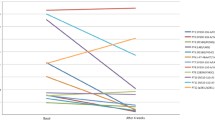Abstract
Chemically defined or elemental medical foods provide the majority of protein equivalent in the diets of children treated for phenylketonuria (PKU). Because of the restricted intake of high biologic value protein, children with PKU often have lower than normal plasma concentrations of ferritin and zinc. Few reported studies are available on vitamin status of children with PKU undergoing treatment. This report addresses intakes of iron, zinc and vitamin A and their plasma concentrations in children ingesting either a low phenylalanine (Phe) casein hydrolysate or a Phe-free L-amino acid mix. With significantly greater than recommended mean intakes of iron and low to recommended mean intakes of zinc, individual plasma ferritin concentrations were often in the deficient (<12 ng/ml) or marginal (12<20 ng/ml) range; plasma zinc concentrations were usually normal when patients received an L-amino acid mix. When L-amino acids were the source of protein equivalent for infants, 48% of plasma retinol concentrations were in the marginal (20<30 µg/dl) or deficient range (<20 µg/dl) in spite of most vitamin A intakes being greater than Recommended Dietary Allowance for age. Some hypothetical reasons for low concentrations of plasma ferritin and retinol are discussed.
Similar content being viewed by others
Abbreviations
- Phe :
-
phenylalanine
- PKU :
-
phenylketonuria
- RBP :
-
retinol binding protein
- RDA :
-
Recommendend Dietary Allowance
References
Acosta PB, Wenz E (1971) Nutrition in phenylketonuria. In: Bickel H, Hudson FP, Woolf L (eds) Phenylketonuria and some other amino acid disorders. Thieme, Stuttgart, pp 181–196
Acosta PB, Fernhoff PM, Warshaw HS, et al (1981) Zinc and copper status of treated children with phenylketonuria. JPEN 5:406–409
Acosta PB, Greene C, Yannicelli S, et al (1993) Nutrition studies in treated infants with phenylketonuria. Intl Pediatr 8:63–73
Acosta PB, Stepnick-Gropper S, Clarke-Sheehan N, et al (1987) Trace element status of PKU children ingesting an elemental diet. JPEN 11: 287–292
Bei L, Wood RJ, Rosenberg IH (1986) Glucose polymer increases jejunal calcium, magnesium, and zinc absorption in humans. Am J Clin Nutr 44: 244–247
Bezkorovainy A (1980) Biochemistry of nonheme iron. Plenum Press, New York, pp 127–206
Casey CE, Walravens PA, Hambidge KM (1981) Availability of zinc: loading tests with human milk, cow’s milk and infant formulas. Pediatrics 68: 394–396
Cook JD, Noble NL, Morck TA, et al (1983) Effect of fiber on nonheme iron absorption. Gastroenterology 85: 1354–1358
Food and Nutrition Board (1989) Recommended dietary allowances 10th edn., National Academy of Sciences, National Research Council, Washington, DC
Greger JL, Snedeker SM (1986) Effect of dietary protein and phosphorus levels on the utilization of zinc, copper and manganese by adult males. J Nutr 110:2243–2253
Goldberg L, Smith JP (1960) Vitamin A deficiencies in relation to iron overloading in the rat. J Pathol Bacteriol 8: 173–180
Harzer G, Kauer H (1982) Binding of zinc to casein. Am J Clin Nutr 35: 981–987
Ingenbleek Y, Young V (1994) Transthyretin (prealbumin) in health and disease: nutritional implications. Ann Rev Nutr 14:495–533
Kelsay JL, Jacobs R, Prather ES (1979) Effect of fiber from fruits and vegetables on metabolic responses of human subjects. III. Zinc, copper and phosphorus balances. Am J Clin Nutr 32: 2307–2311
Lukaski HC, Klevay LM, Bolonchuk WW, et al (1982) Influence of dietary lipids on iron, zinc and copper retention in trained athletes. Fed Proc 41: 275 (Abstr)
Mead JF (1984) The non-eicosanoid functions of the essential fatty acids. J Lipid Res 25:1517–1521
Meadows NJ, Grainger SL, Ruse W, et al (1983) Oral iron and the bioavailability of zinc. BMJ 287:1013–1014
Mejia LA, Hodges RE, Arroyave C, et al (1977) Vitamin A deficiency and anemia in Central American children. Am J Clin Nutr 30:1175–1184
Mejia LA, Hodges RE, Rucker RB (1979) Role of vitamin A in the absorption, retention and distribution of iron in the rat. J Nutr 109:129–137
Mills CF (1985) Dietary interactions involving the trace elements. Ann Rev Nutr 5:173–193
Monsen ER, Cook JD (1976) Food iron absorption in human subjects. IV. The effects of calcium and phosphate salts on the absorption of nonheme iron. Am J Clin Nutr 29:1142–1148
Roodenburg AJC, West CE, Yu S, Beynen AC (1994) Comparison between time-dependent changes in iron metabolism of rats as induced by marginal deficiency of either vitamin A or iron. Br J Nutr 71:687–699
Shenton A, Wells FE, Addison GM (1983) Prealbumin as an indicator of marginal malnutrition in treated phenylketonuria: a preliminary report. J Inherited Metab Dis 6: [Suppl 2]: 109–110
Sidransky H, Sarma DS, Bongiorno M, Verney E (1968) Effect of dietary tryptophan on hepatic polyribosomes and protein synthesis in fasted mice. J Biol Chem 243:1123–1132
Sievers E, Oldigs HD, Dorner K, et al (1988) Trace element overload in PKU — Diet? Pediatr Res 24:270 (Abstract)
Solomons NW, Jacob RA (1981) Studies on the bioavailability of zinc in man. IV. Effect of heme and nonheme iron on the absorption on zinc. Am J Clin Nutr 34:475–481
Valberg LS, Flanagan PR, Chamberlain MJ (1984) Effects of iron, tin and copper on zinc absorption in humans Am J Clin Nutr 40:536–541
Van Dokkum W, Cloughley FA, Hulshof KFAM, et al (1983) Effect of variations in fat and linoleic acid intake on the calcium, magnesium and iron balance of young men. Ann Nutr Metab 27:361–369
Author information
Authors and Affiliations
Rights and permissions
About this article
Cite this article
Acosta, P.B. Nutrition studies in treated infants and children with phenylketonuria: vitamins, minerals, trace elements. Eur J Pediatr 155 (Suppl 1), S136–S139 (1996). https://doi.org/10.1007/PL00014231
Issue Date:
DOI: https://doi.org/10.1007/PL00014231




